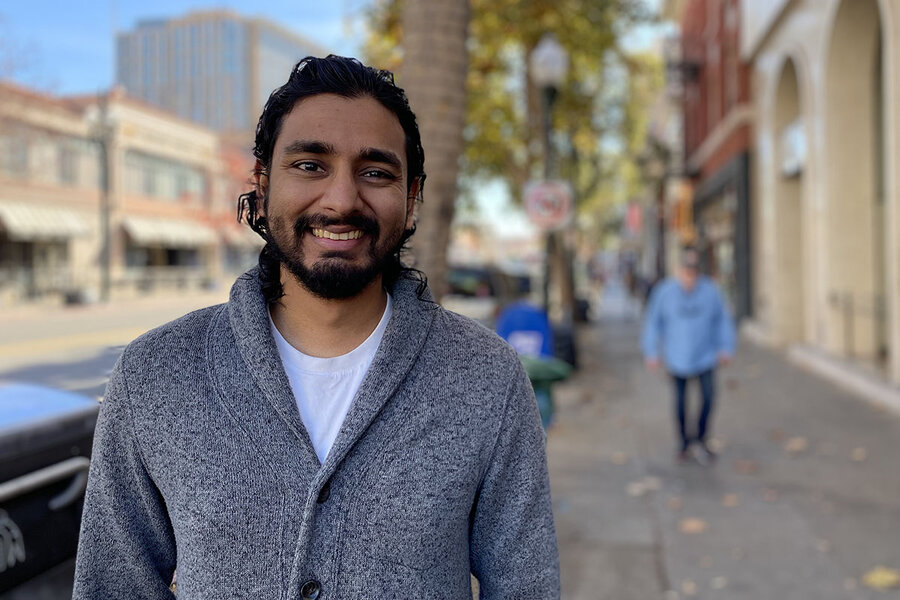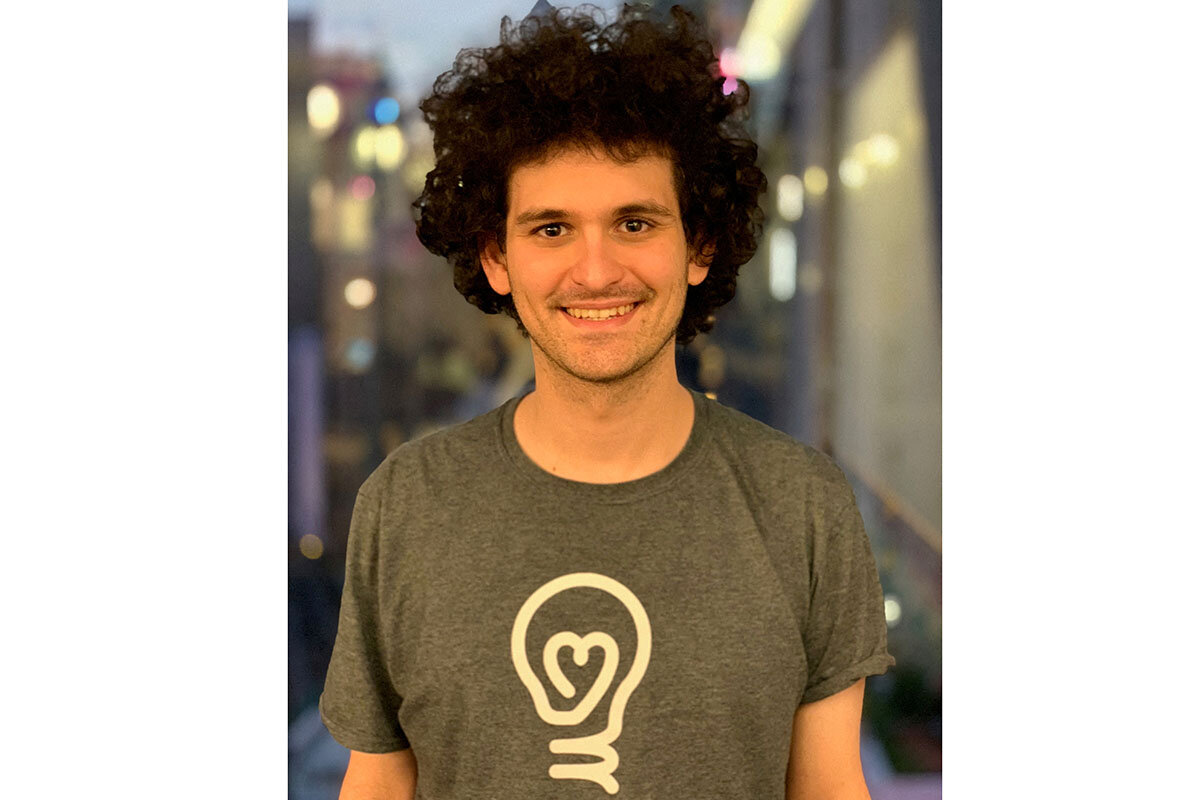Wider fallout from a crypto collapse: How should charity really be done?
Loading...
| BERKELEY, CALIF.
A trend-setting movement in philanthropy is undergoing an earthquake of criticism and self-examination because of something that on the surface seems wholly unrelated: the crumbling of a cryptocurrency exchange.
What links the two stories is Sam Bankman-Fried, who co-founded the exchange (FTX), grew rich, and was committed to giving money away under a philosophy known as effective altruism. When the company collapsed into bankruptcy amid allegations of misusing customer funds, questions of business governance were joined by ones of charitable philosophy.
The question in short: Does the imploding fortune of Mr. Bankman-Fried – the movement’s wealthiest known figurehead, who was arrested Monday in the Bahamas – tarnish the reputation of one individual or undercut the credibility of a whole movement he represented?
Why We Wrote This
A story focused onThe movement known as effective altruism has gained a wide following among many smart and selfless people. Now a controversy prompts calls to rethink how that generosity is put into practice.
Effective altruists are devoted to a brand of philanthropy that aspires to be both expansively generous and rigorously intellectual. They are united in their commitment to a basic maxim: Do the most possible good with the resources you have. The philosophy rests on the premise that all lives are valued equally, and each of us has a responsibility to improve the lives of others if we can. While the concepts are not exactly new, the movement has attracted tens of thousands of followers, and mobilized billions of dollars for charity, since its intellectual birth at Oxford University a decade ago.
For the rest of society, qualms about effective altruism have raised worthwhile questions about how to do good responsibly.
Generosity is generally considered a virtue, especially when intentions are pure. But the case of Mr. Bankman-Fried suggests that generosity on its own is not enough, requiring a backbone of ethical integrity. The movement’s focus on quantifiable cost-benefit analysis may need to be matched with less measurable values, like intellectual humility and pluralism. Meanwhile, concerns about how “good” itself is defined and measured are rising to the surface. Some critics say that, for all its efforts at rigor, effective altruism hasn’t lived up to the standard of moral integrity.
“It’s initially attractive,” says Alice Crary, a philosopher at the New School for Social Research in New York. But she worries the impact is illusory, given what she sees as a narrow, oversimplified, and even arrogant approach to the world’s problems. “It focuses on improving benchmarks in systems that often do great harm without challenging the systems themselves.”
Quantitative mindset
That’s a criticism effective altruists are used to hearing. Valmik Prabhu even thinks it’s a valid one.
“I’m friends with a lot of social justice people, and it can feel like the thing they want to do is so big, and they have no idea how to do it,” he says at a cafe located blocks from where he was introduced to effective altruism as a student at the University of California, Berkeley, and near the house he lives in now with 11 other effective altruists. Systemic change is important, he says, but “there are a lot of problems where money can do good.”
A vegan and animal welfare activist before learning of effective altruism, Mr. Prabhu had read Peter Singer, the famed philosopher and intellectual father of the movement. He’s famous for the drowning child thought experiment: If you would rescue a drowning toddler from a nearby pond, you are similarly responsible for saving the life of someone in a poor part of the world if you have the resources.
Effective altruists take that responsibility seriously. It also means every dollar counts.
“It’s applying the same sort of quantitative mindset that I use in the rest of my life to doing good,” Mr. Prabhu explains. He points out that people go to great lengths to optimize trivial decisions, such as which product to select on Amazon, but don’t bother to apply that same rigor to their generosity.
Mr. Bankman-Fried, currently being investigated for fraud, was effective altruism’s highest-profile champion. After graduating from the Massachusetts Institute of Technology in 2014, he was encouraged by one of the philosophy’s founders, Will MacAskill, to “earn to give,” one way effective altruists seek to do good. He took the advice to heart. This year alone, the fallen luminary had committed some $50 million to effective altruism-aligned organizations through FTX Foundation’s Future Fund, the charitable branch of FTX.
Most effective altruists – sometimes referred to as EAs – have condemned any immoral or illegal actions taken by Mr. Bankman-Fried, as well as the idea that a theoretically positive outcome from philanthropy could have justified mismanaging customer funds. Many have revised statements heralding his success as a model to follow. The Future Fund team quickly resigned. According to one organizer, the movement as a whole has lost about one-third of its funding.
At the same time, many devotees like Mr. Prabhu are unfazed by Mr. Bankman-Fried. “People trusted him because he shared our values,” says Mr. Prabhu. “A lot of EAs definitely felt very betrayed.” While he’s concerned about the influence of large, single funders, he points out that Mr. Bankman-Fried wasn’t an intellectual contributor to the movement.
He and others in his co-op have signed on to the Giving What We Can pledge, promising to donate at least 10% of their lifetime income to highly vetted charities as part of an initiative launched in 2009 by the founders of effective altruism.
His roommate Richard Yannow signed the pledge in 2014 when he took his first job after college as a software engineer at Google. Living frugally, he ramped up his contribution to 50% of his salary. That’s over $100,000 each year, which he divides among a handful of organizations recommended by the effective altruism organization GiveWell, working in malaria prevention, direct cash transfers, and animal welfare.
Some charitable organizations have long been criticized for addressing the symptoms of complex political and economic problems, rather than root causes.
“That can often be a false dichotomy,” says Mr. Yannow. “It can be the case that giving people more material resources on the margin can change the political balance.” With more immediate needs met, he says marginalized individuals are better positioned to advocate for their wider interests. In recent years, some effective altruists have turned their attention to structural solutions like prison reform and YIMBYism. And he appreciates the movement’s willingness to revise its positions on certain issues when needed.
Since the collapse of FTX, he says he’s been impressed with the amount of “criticism and earnest self-reflection from within the community.”
Whose metrics?
Earnest self-reflection is exactly what some in the social impact realm think the effective altruism movement could use more of.
Effective altruism evaluates causes using three lenses: impact, tractability, and neglectedness. GiveWell chooses a handful of top charities each year based on the organizations that “save or improve lives the most per dollar.” Malaria nets, for example, are estimated to save lives at $5,500 per life.
But critics point out that no quantitative valuation is free from human bias. Take the GiveWell calculation of cost-effectiveness. Parameters such as costs, expenses, and certain measurable outcomes are combined with normative parameters, called “moral weights,” to reach the evidence-based conclusions it promises. While GiveWell has at times conducted surveys to ask beneficiaries for input on the relative values of different program outcomes, moral weights are heavily informed by the values of staff members.
“Who gets to determine what is logic and what is reason? Who gets to determine the metrics and how you’re measuring impact?” asks Rodney Foxworth, CEO of the nonprofit Common Future, and a leader in community investing in Baltimore. “It diminishes other cultural ways of knowing and making determinations.”
The most recent demographic survey found that the effective altruism movement is 76% white, less than 1% Black, 2% Hispanic, and 0% Indigenous, and 71% male. Most attended some of the most prestigious universities in England, the United States, and Australia.
That homogeneity may have something to do with the circles in which the movement got its start. It’s also possible the highly analytical and quantitative framework is particularly attractive to a specific, yet unrepresentative, portion of global society, akin to what anthropologist Joseph Henrich calls the WEIRD minority – those raised in Western, educated, industrialized, rich, and democratic places who tend to be unusually analytical, individualistic, and concerned with personal responsibility.
The wider ethical framework of utilitarianism, which informs effective altruism, has long been influential in realms from philanthropy to public policy, but it can also be controversial. Doing the “greatest good for the greatest number” can be a challenge without running afoul of hubris, naiveté, or ends-justify-the-means thinking – an attitude some critics suspect may be at the center of Mr. Bankman-Fried’s debacle at FTX.
And there are some things humans care about – think freedom, justice, or beauty – that are difficult, if not impossible, to measure with abstract quantitative tools.
At best, the effort to scientifically determine the impartial “highest good” is confused. At worst, it’s reminiscent of a “colonizing logic,” says Professor Crary, whereby wealthy individuals use their own rationale and metrics to determine the fate of those less fortunate. She and two colleagues are editing a forthcoming book on effective altruism called “The Good It Promises, The Harm It Does: Critical Essays on Effective Altruism.” She says a better approach for young people who want to make a difference is to start from a position of immersion and appreciation of local values.
Evolving and revising
Rockwell Schwartz disagrees with the portrayal of effective altruism as insular and narrow-minded – a “feel-good pet project based on a techno-elitist subculture,” says the director of Effective Altruism NYC.
After the initial shock of the FTX collapse, Ms. Schwartz stopped worrying about what Mr. Bankman-Fried might have been thinking. Like others, she is pushing for stronger checks, balances, and governance structures. “How do we have a community that has infrastructure in place so that it doesn’t matter what is going on in one individual’s head?” she says.
She’s glad her community has “an active, built-in desire for adaptability in the face of new information.” That includes some of the group’s fundamental premises. “People are thinking about these things deeply and willing to really engage in conversation to improve their own thinking as part of improving their world.”
Those arguments may lead to unfashionable conclusions, such as the shift in recent years to a focus on “longtermism,” a controversial strand of effective altruism that revolves around the (very) long-term future of humanity. But one prediction made by Toby Ord, co-founder of the effective altruism movement, in his 2020 book on longtermism, “The Precipice,” rings eerily true:
“A single person acting without integrity could stain the whole cause and damage everything we hope to achieve.”







